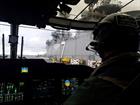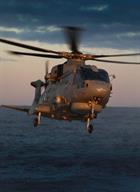Merlin magic hunts down ‘enemy’ submarines in NATO war games
Our ‘Arctic Tigers’ have further honed their submarine-hunting skills during a two-week exercise in the beautiful, but icy, waters around Norway. 814 Naval Air Squadron (aka the Flying Tigers) sent teams and two Merlin Mk2 helicopters to join frigates HMS Northumberland and Westminster as part of NATO’s Exercise Trident Juncture. Their mission – in tandem with the frigates which are also dedicated sub hunters – was to ‘protect’ a task group of more than half a dozen ships, especially flagship USS Iwo Jima, from underwater attack.
Two ships’ flights from 814 NAS have just returned from NATO’s largest exercise in many years off the coast of Norway. Trident Juncture 18 was a huge exercise with 50,000 participants, 150 aircraft and 65 vessels from more than 30 nations, providing plenty of chances for the crews from RNAS Culdrose to show what they are made of.
Type 23 Frigates HMS Northumberland and HMS Westminster both had Merlin Mk 2 helicopters embarked and the Flights, comprising a mixture of engineers and aircrew, had to quickly get acclimatised to operating in temperatures that regularly hovered below zero. Having sailed from Reykjavik in Iceland on 22 October, the Ships and their flights exercised alongside their coalition partners from across NATO in a simulated high threat environment. The Merlin Mk 2 is primarily an anti-submarine helicopter and the aircraft were used day and night to detect and deter ‘enemy’ submarines.
Not long into the exercise, the Ships came up against their first live submarine from the host nation, Norway. This submarine was operating within its own backyard, utilizing the water space to its advantage, however the ships had their secret weapon on board; the Merlin helicopter. HMS
Northumberland’s aircraft was launched late at night and disappeared into the darkness to locate, track and prosecute the ‘enemy’. Once ‘in the dip’, the term used when the helicopter’s FLASH SONAR equipment is lowered into the sea, the crew began their hunt with Petty Officer (Aircrewman) Dobson immediately getting a ‘sniff’ of something underwater. He had to work hard to regain and hold the contact, which was clearly using its knowledge of the oceanography in the area to try and evade, but soon the classification rose and Command approved ‘weapons free’. Two simulated attacks later, with the enemy neutralized, the Merlin could return to her floating home.
Alongside its anti-submarine duty, the aircraft was used for a number of secondary roles including acting as a helicopter delivery service amongst the ships in the NATO Task Group. During Trident Juncture, Northumberland’s Merlin landed on the USS Iwo Jima, a Wasp class LHD which is just a little smaller than the UK’s new Queen Elizabeth Class Aircraft Carrier. This was a first for one of the flight’s pilots, Lt Ross Wiltshire, who enjoyed the opportunity to land on a ship so large.
“It is really good to prove our ability to operate with our closest allies and Exercise Trident Juncture has done just that, showing that we can operate to a foreign amphibious ship such as the USS IWO JIMA,” said Lt Wiltshire. “Landing on such a big flight deck, after flying from the Royal Navy’s smallest, was quite a contrast but is definitely a career highlight for me.”
Meanwhile, back on deck, the engineering team worked exceptionally hard in the freezing, wind-swept conditions to keep the aircraft operational.
“This exercise has provided the flight with an excellent opportunity to put into practice a lot of the skills we covered during operational sea training,” explained Chief Petty Officer (Air Engineering Technician) ‘Jules’ Andrews, Northumberland’s Senior Maintenance Rating (SMR). “The flight engineers have shown throughout the exercise we can operate at a high standard from the flight deck of a Frigate; working long shifts in very arduous conditions.”
Exercise Trident Juncture 18 provided to be an excellent opportunity for the two ships’ flights to practice their seagoing skills, both airborne and as fully involved members of the ships’ company; from conducting firefighting and damage control to racing to get the aircraft airborne to counter the underwater threat, all whilst working alongside our NATO allies. And all of this done within the beautiful, but cold, waters of the glorious Norwegian coastline.









